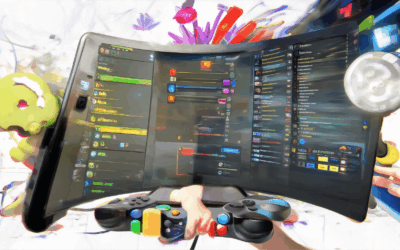Independent game developers often face a unique set of challenges, from securing adequate funding to navigating the complexities of project management and marketing. Among the most pressing issues for many in this space is accessing reliable and sustainable financial support, which is where indie dev funding grants come into play. These grants, designed to assist independent developers in bringing their creative visions to life, offer a vital resource for those looking to break into the competitive world of game development. Whether you’re a seasoned indie developer or just starting out, understanding the various funding avenues available can make a significant difference in your journey. In this comprehensive guide, we’ll explore everything you need to know about indie dev funding grants, including how to identify the right opportunities, what to expect from the application process, and how to maximize your chances of success. By equipping yourself with the knowledge and strategies outlined in this article, you can unlock the resources needed to turn your passion for gaming into a thriving career.
Key Takeaways
– Leverage Crowdfunding Platforms: Connect with backers on platforms like Kickstarter or Indiegogo to crowdfund your indie game and secure upfront funding.
– Explore Game Development Grants: Apply for grants from organizations like Unity Technologies to support your creative projects.
– Engage with Developer Communities: Join forums like Unreal Engine Forums or GameDev.net to network, collaborate, and discover funding opportunities.
– Collaborate to Reduce Costs: Partner with other developers or artists through platforms like OpenCollective to share resources and lower expenses.
– Approach Angel Investors and VCs: Pitch your game idea to specialized investors like Kicker Venture Capital for potential funding and mentorship.
– Consider Bootstrapping: Use personal savings or loans cautiously if traditional funding isn’t available.
– Secure Publishing Deals: Partner with publishers like Polygon for funding and distribution support.
– Build a Strong Online Presence: Utilize social media and pre-sales to promote your game and attract backers.
– Understand Development Costs: Plan your budget considering expenses like game engine licenses, marketing, and testing for indie, AAA, or mobile games.
– Adapt to Changing Funding Landscape: Explore alternative funding sources due to the shutdown of the Indie Fund, focusing on community support and innovative approaches.
– Embrace Creativity and Innovation: The Indie Fund’s legacy inspires ongoing support for unique and high-quality indie games.

Funding Options for Indie Developers
Indie developers utilize various methods to secure funding for their projects:
- Sales and Revenue Models: Selling games or apps directly through platforms like Steam, Apple App Store, Google Play, and others. Revenue can come from one-time purchases, in-app purchases, subscriptions, or freemium models.
- Crowdfunding Campaigns: Platforms like Kickstarter, Indiegogo, and Patreon allow indie developers to raise funds by pre-selling their games or securing monthly supporter income.
- Bank Loans and Investors: Securing traditional loans or attracting angel investors who believe in the project’s potential. Some developers also turn to venture capital firms for larger investments.
- Pre-Sale Orders: Offering early access to beta versions or exclusive content in exchange for upfront payments to fund development.
- Partnerships and Collaborations: Partnering with other developers, artists, or designers to share risks and resources. Sometimes, collaborating with established studios can provide funding or distribution channels.
- Grants and Competitions: Applying for game development grants, participating in game jams, or entering competitions that offer cash prizes or development funds.
- Revenue Sharing Models: Partnering with platforms that offer revenue sharing agreements, allowing indie developers to retain ownership while still earning from their work.
- Freelance and Side Projects: Many indie developers work full-time jobs to save money, which they then use to fund their passion projects independently.
Each method comes with its own set of challenges and considerations, but these options provide diverse pathways for indie developers to fund their creative endeavors.
What is a Good Budget for an Indie Game?
Your budget for an indie game depends on several factors, including the game’s scope, platform, and marketing strategy. Here’s a breakdown:
- Game Size and Complexity: – Simple games (e.g., mobile or casual) may cost $5–$15. – Mid-sized games (e.g., 10+ hours of content) typically range from $15–$25. – Ambitious projects with advanced features can cost $25–$70.
- Platform Considerations: – Console releases may incur additional fees ($100–$500 depending on platform). – Mobile apps face app store fees (typically 15–30% of revenue).
- Marketing and Promotion: – Allocating $0–$20k for digital advertising, influencer partnerships, and event attendance can boost visibility.
- Development Timeline: – Solo projects may cost $10–$30k, while teams with salaries could spend $50k–$150k+
- Post-Launch Strategy: – Budgeting $5–$20k for updates, DLCs, and expansion packs can prolong success.
For optimal results, assess your project’s scale, platform, and goals before finalizing your budget. Consider researching similar games and their development costs to align your finances with your vision.

What is the Indie Funding Program?
The Indie Fund is a dedicated initiative designed to support and finance independent game developers. Our program aims to provide financial assistance, mentorship, and resources to creators working on innovative and unique projects. By partnering with experienced professionals in the gaming industry, we strive to foster growth and success for the next generation of game developers.
How Does the Indie Fund Work?
The Indie Fund operates through a competitive application process where developers submit their projects for consideration. Applications are evaluated based on creativity, innovation, development potential, and the likelihood of contributing positively to the gaming community. Successful applicants receive funding along with access to our network of mentors and industry contacts.
Application Requirements
To apply for the Indie Fund, developers must submit the following materials: – A detailed project overview, including concept art, gameplay mechanics, and development timeline – A budget plan outlining intended use of funds – A team profile showcasing past experiences and expertise – A pitch video or presentation (optional)
Benefits of the Indie Fund
Participating in the Indie Fund offers numerous advantages: – Financial support to bring your vision to life – Access to industry experts for guidance and feedback – Exposure through promotional activities and events – Networking opportunities with potential partners and collaborators
Competitor Programs
While the Indie Fund stands out, there are several alternative funding options available to independent developers. We recommend exploring programs like the GameDevFund and the Unity Fund</a), which offer similar opportunities. These programs each have their own strengths, and we encourage developers to research thoroughly before applying.
By joining the Indie Fund, you’re not just seeking financial support—you’re investing in your future as a game developer. Our commitment is to help you succeed, whether through direct funding or connecting you with the right resources. Let’s build the next big thing together.

How to Get Your Game Funded
Funding a game project can open doors to various opportunities, but it requires careful planning and strategy. Here are some effective methods to secure funding for your game:
- Crowdfunding Platforms: Start by exploring platforms like Kickstarter or Indiegogo . These platforms allow you to pitch your game to potential backers and raise funds through pre-orders or donations.
- Game Development Grants: Look for grants or competitions specifically designed for indie game developers. Organizations like the Unity Technologies offer programs such as the Unity Accelerator Program to support creative projects.
- Community Support: Engage with game development communities and forums. Websites like Unreal Engine Forums or GameDev.net often have sections dedicated to funding and collaboration opportunities.
- Collaborative Projects: Partnering with other developers or artists can help reduce costs and increase the chances of securing funding. Consider joining forces with friends or finding collaborators through platforms like OpenCollective .
- Angel Investors and VC Firms: Reach out to angel investors or venture capital firms that specialize in gaming startups. Companies like Kicker Venture Capital focus exclusively on game-related investments.
- Bootstrapping: If traditional funding isn’t an option, consider bootstrapping your project. Use personal savings or loans to cover initial development costs, though this approach carries financial risks.
- Publishing Deals: Partnering with a publisher can provide funding and access to their distribution networks. Publishers like Polygon work with indie developers and take a percentage of revenue upon release.
- Social Media and Pre-Sales: Build a strong online presence and engage with your audience early. Platforms like Twitter and Facebook can help you promote your game and attract potential backers.
Funding a Game: Costs and Considerations
The cost of funding a game can vary widely depending on the scope, complexity, and goals of the project. Here’s a breakdown of the typical expenses involved:
Indie Games
For independent developers, the budget typically ranges from:
- $50,000 – $500,000
This range covers:
- Game engine licenses (e.g., Unity, Unreal)
- Artist and programmer salaries (if applicable)
- Sound design and music
- Marketing and distribution fees
- Testing and iteration costs
AAA Games
High-budget games, particularly those from AAA studios, can cost:
- $20 million – $300+ million
These figures include:
- Large-scale production costs
- Advanced graphics and animation
- Marketing campaigns
- Platform holder fees (e.g., console manufacturer percentages)
Mobile Games
Mobile games often have lower development costs due to smaller screen sizes and reduced complexity:
- $10,000 – $100,000
Factors influencing costs include:
- Use of pre-made assets
- Simplified physics and graphics
- Focus on monetization strategies
Additional Costs
Beyond development, other expenses to consider include:
- Marketing and advertising
- Distribution platform fees (e.g., App Store, Steam)
- Beta testing and localization
- Legal fees for contracts and intellectual property
Business Model Impact
The chosen business model can significantly affect funding requirements. Crowdfunding platforms may impose:
- Platform fees (e.g., Kickstarter)
- Marketing expenses
- Production costs
Alternatively, securing investors may require:
- Equity stakes
- Royalty payments
- Profit-sharing agreements
Examples and Case Studies
Successful games like “Minecraft” were developed with modest budgets, while AAA titles like “The Last of Us” had multimillion-dollar budgets. These examples highlight the importance of a clear vision and budget planning.
Conclusion
Funding a game involves careful consideration of development costs, marketing strategy, and business model. By understanding these factors, developers can better estimate their budget and plan accordingly.
For more insights and resources on game development, visit Indie Dev Games .

What Happened to the Indie Fund?
The Indie Fund, once a prominent force in supporting independent game development, faced significant changes in recent years. The fund, initially established by OATV (formerly known as Indie.vc), played a crucial role in nurturing indie games by providing financial backing and mentorship to developers. However, the fund’s operations officially ceased in 2023 due to challenges in securing investor commitments for its next iteration.
The Shutdown of Indie.vc
In 2023, OATV announced the discontinuation of the Indie Fund program. This decision followed a significant drop in investor interest, particularly with the fourth fund being met with skepticism from 80% of the original investor base. Despite this, OATV emphasized that the vision behind the Indie Fund would continue through alternative means, signaling their commitment to supporting indie developers.
The Impact on Indie Game Development
The closure of the Indie Fund has had noticeable effects on the indie game development ecosystem. While the fund’s direct financial support is no longer available, its legacy lies in the many successful games it backed during its active years. Developers who benefited from the fund have expressed gratitude for the opportunities it provided, though the loss of a dedicated funding source has led some to seek alternative avenues for financing.
The Legacy of the Indie Fund
The Indie Fund will be remembered for its emphasis on fostering creativity and innovation in the gaming industry. By focusing on independent developers, the fund helped bring unique and high-quality games to audiences worldwide. Its influence can still be felt today, as many of the developers it supported continue to create groundbreaking work in the industry.
A New Era for Indie Games
While the Indie Fund may no longer exist, the spirit of supporting independent games persists. Platforms like Indie Dev Games offer valuable resources and communities for developers, ensuring that the journey of creating indie games remains a vibrant and thriving endeavor.
Conclusion
The Indie Fund’s story is one of adaptation and resilience. Although its operational phase has come to an end, its impact on the indie game landscape continues to shape the future of gaming. As developers adapt to new challenges and opportunities, the legacy of the Indie Fund serves as inspiration for the next generation of creative endeavors in the gaming world.




0 Comments